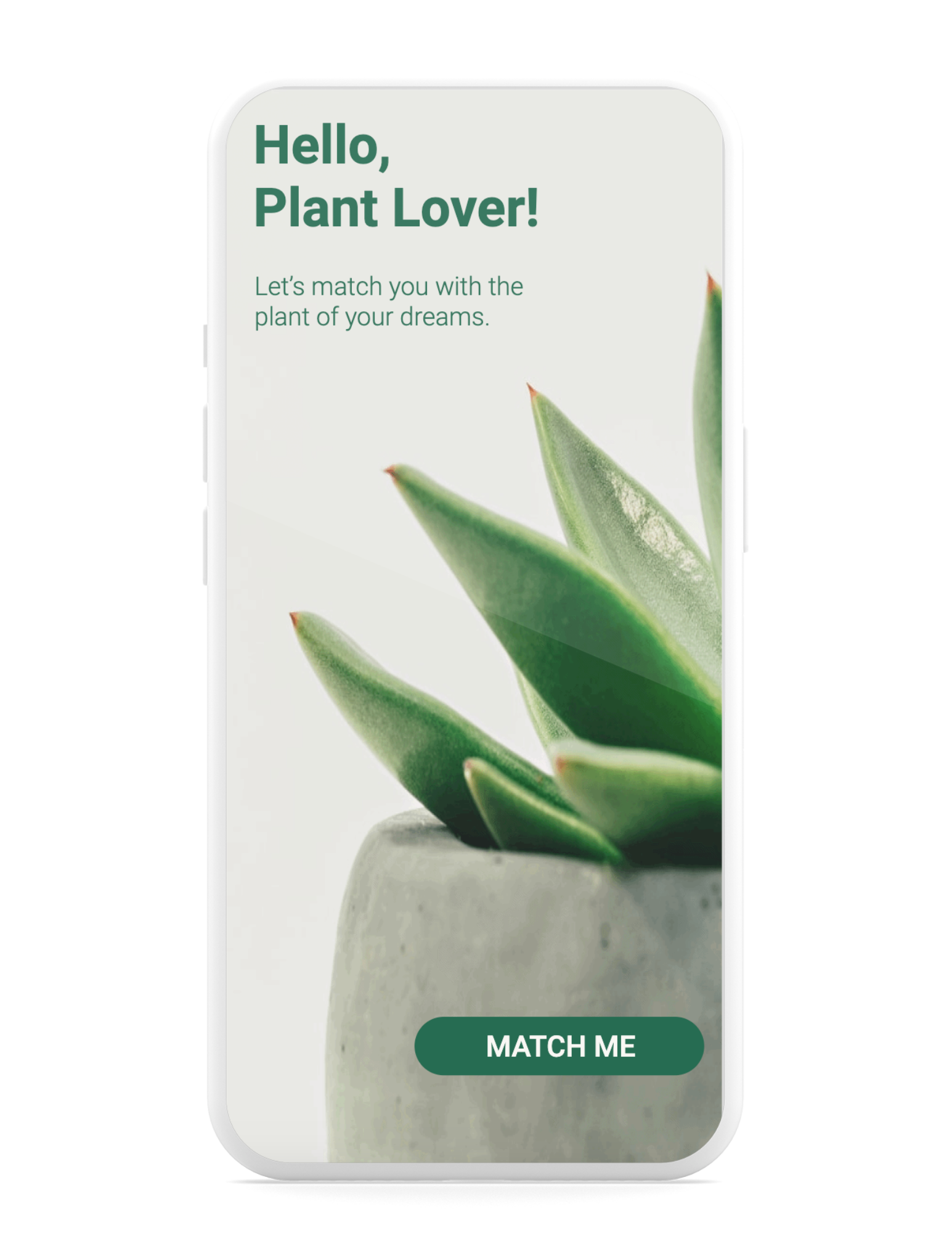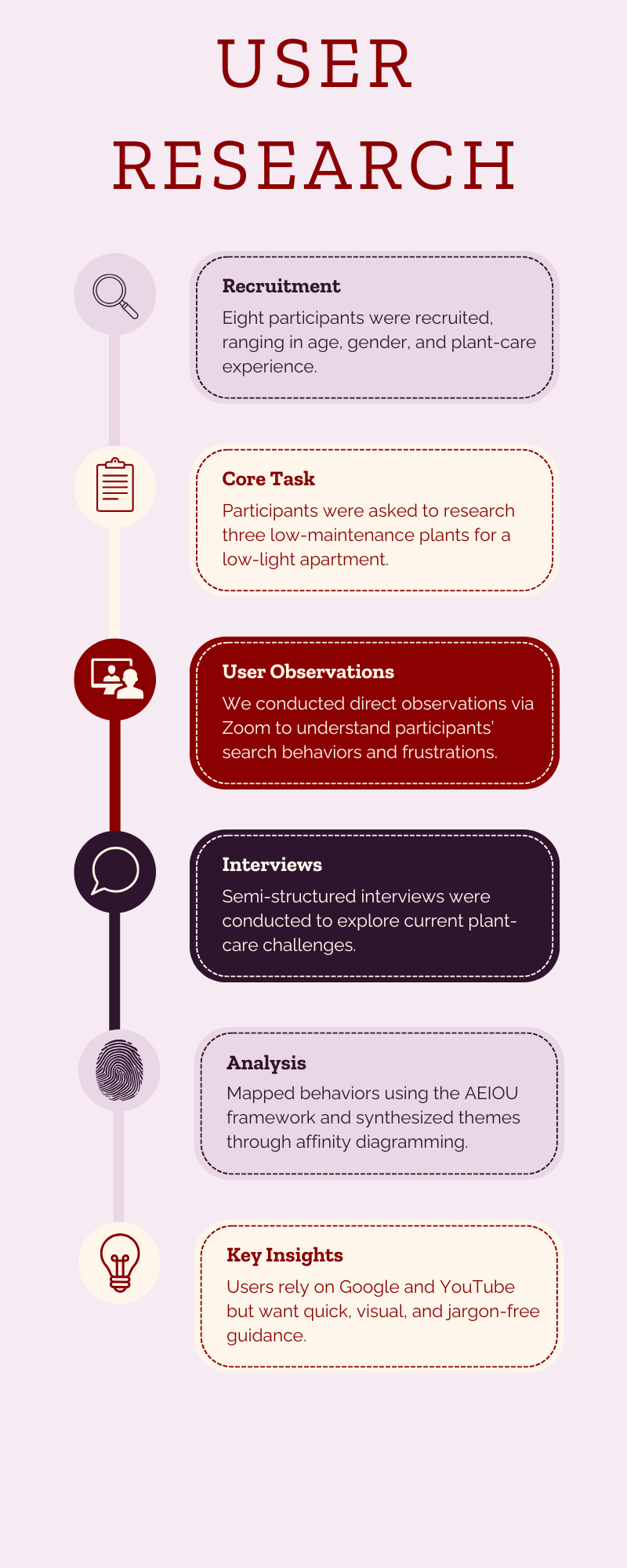Modernizing Plant Care:
Roots App
A mid-fidelity concept focused on simplifying how users research, buy, and care for plants.
The Case
Timeline
Research (2022)
Design & Prototyping (2023)
Role
UX Researcher & Designer
Project
Academic
Team
Group collaboration for research; independently led design and prototyping.
Tools
Atlas.ti, Figma, Axure
Problem Statement: Many plant lovers struggle to find a reliable platform that not only helps them purchase plants, but also guides them in plant care and maintenance. The challenge was to create a seamless experience for users to research, buy, and confidently care for their plants in one place.
Project Description: Roots is a plant care mobile app designed to help users research, purchase, and maintain plants. The app aims to bridge the knowledge gap between plant enthusiasts and the optimal care for their plants, providing detailed guides, reminders, and a plant marketplace.
The Investigation
In a world overflowing with plant care apps, videos, and blog posts, novice plant owners are still struggling to keep their greenery alive. Our research set out to uncover why. Despite the abundance of resources, many users find existing tools dense, jargon-filled, and cluttered with ads, making plant care feel intimidating rather than empowering.
We aimed to validate a key hypothesis: that current tools aren't meeting the real needs of everyday users who crave simple, fast, and personalized guidance.
Our guiding question: How might a tech-based solution help users confidently choose and care for indoor plants suited to their unique environments?
Methods
To better understand the challenges novice and experienced plant owners face, we conducted qualitative research using two core methods: remote user observations and semi-structured interviews. Our goal was to uncover behavioral patterns, pain points, and unmet needs that could inform a user-first solution for plant selection and care.
We recruited eight participants (four women, four men) between the ages of 23 and 52. Six participants had up to ten years experience caring for indoor plants. This diversity gave us a balanced view of varying needs, motivations, and habits related to plant care and technology usage.
-
To explore how novice and experienced plant owners approach online plant research and uncover pain points in their decision-making process. We aimed to understand the user’s journey when selecting low-maintenance plants suitable for a low-light environment, and how technology could better support their needs.
-
Demonstrate how you would research three plants that require minimal care in a low-light apartment.
-
We conducted remote observation and interview sessions via Zoom and Microsoft Teams. After introducing ourselves and the project, each participant reviewed an informed consent form and gave verbal permission to proceed.
During the task, we recorded their screens and took detailed notes to capture their search behaviors, actions, tools used, and expressions of frustration or ease. Each session concluded with a short debrief, asking participants how confident they felt in their results and what they found helpful or challenging during the process.
In the interviews, participants were asked to discuss their current plant ownership, plans to purchase new plants, and how digital tools might help them research, maintain, and choose plants more effectively.
-
Each researcher independently analyzed the observation data using the AEIOU framework (Activities, Environments, Interactions, Objects, and Users). We then collaborated to build an affinity diagram to identify common behaviors, patterns, and challenges.
-
Participants often defaulted to Google or YouTube due to familiarity, but struggled to sift through information quickly.
Many skipped over dense or ad-heavy pages, prioritizing short, list-style articles or visual content.
Jargon and overly scientific plant names caused confusion, especially among newer plant owners.
A desire for personalized guidance or filtering tools was consistently voiced when comparing plant options.
We created four spectrums based on interview findings to help develop user personas:
Plant ownership experience (0–10+ years)
Likelihood of seeking expert help
Size of living space
Preference for purchasing plants (local shop vs. chain store)
What We Discovered in the Field
Key Behavioral Pattern
Users move through a consistent decision-making cycle when selecting plants, whether in-store or online.
Core Themes That Emerged
Observed Behaviors by Stage
-
Users rely on Google searches with terms like low light, easy care, and pet-safe.
Many revisit known, trusted sources or use YouTube to explore further.
-
Users cross-reference articles and product details.
They look for clear info on watering, lighting, pests, and pet safety.
-
Confidence grows when care needs are met and advice is confirmed.
Common plant choices included Snake Plant, Monstera, and Cast Iron.
User Snapshots
Two primary personas, Ethan and Nicole, were developed to represent key user types identified during the discovery phase. Ethan, an experienced plant owner, seeks reassurance around pet safety, while Nicole, a first-time buyer, needs guidance and confidence in choosing plants that fit her lifestyle. I mapped their journeys to reveal emotional shifts, friction points, and opportunities to enhance the plant-buying experience across digital and in-store touchpoints.
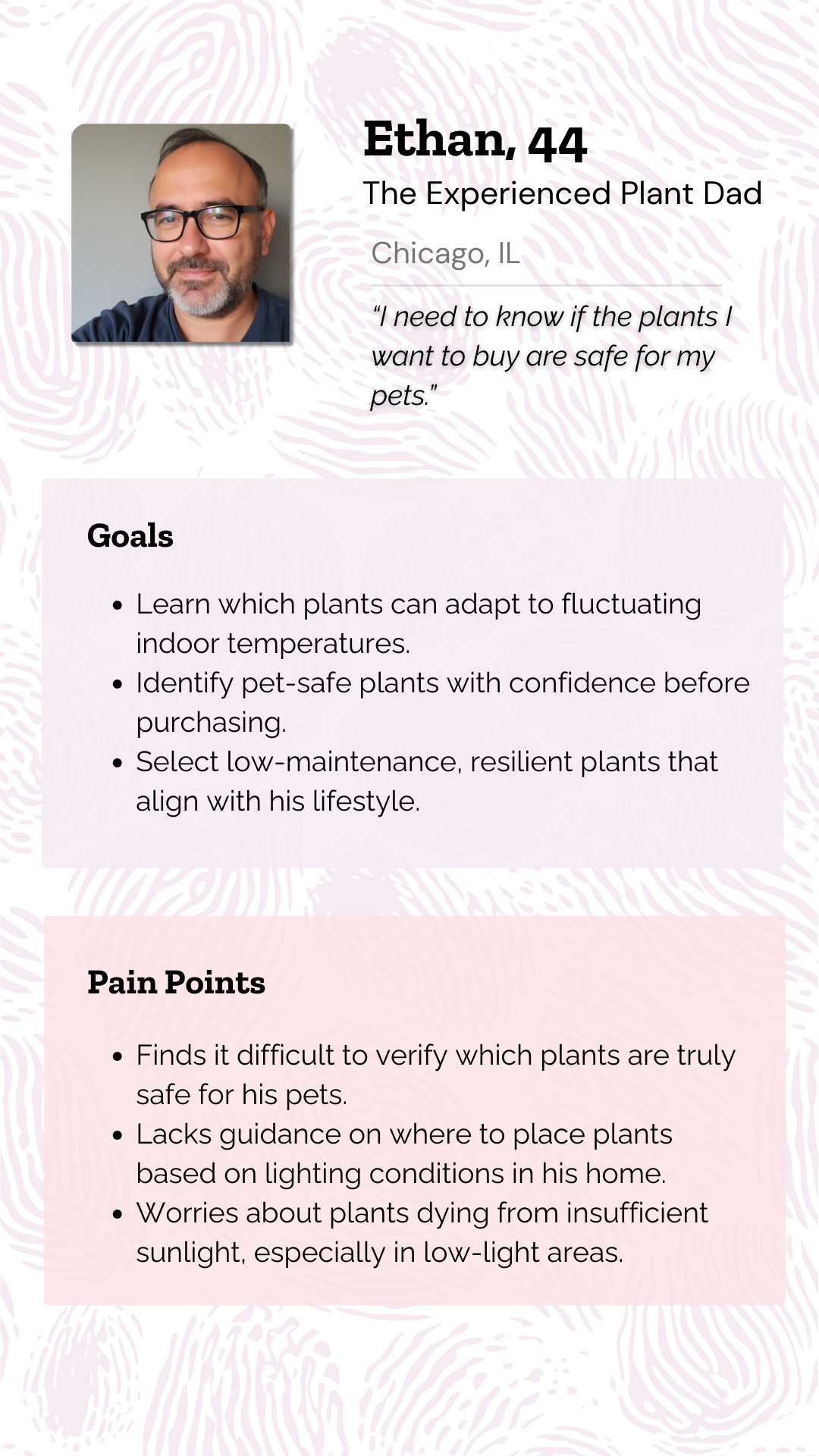



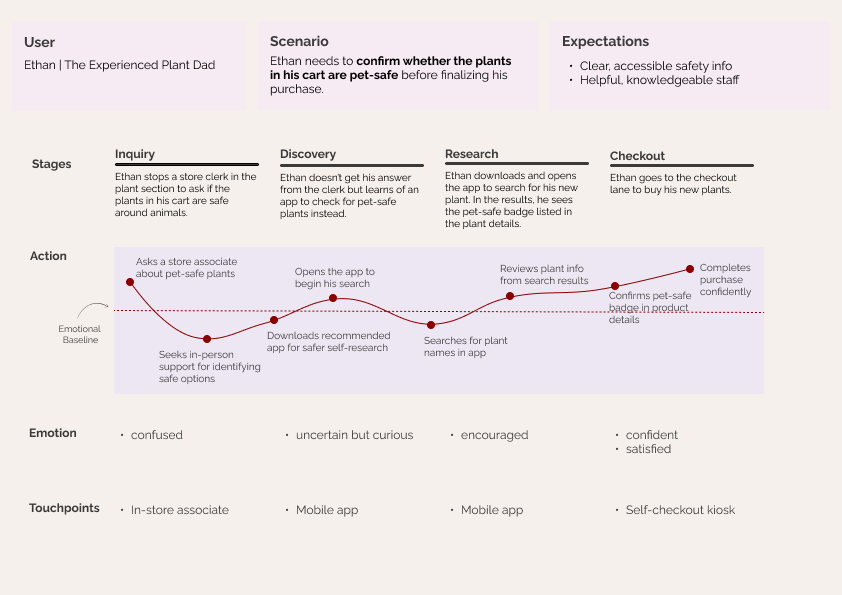
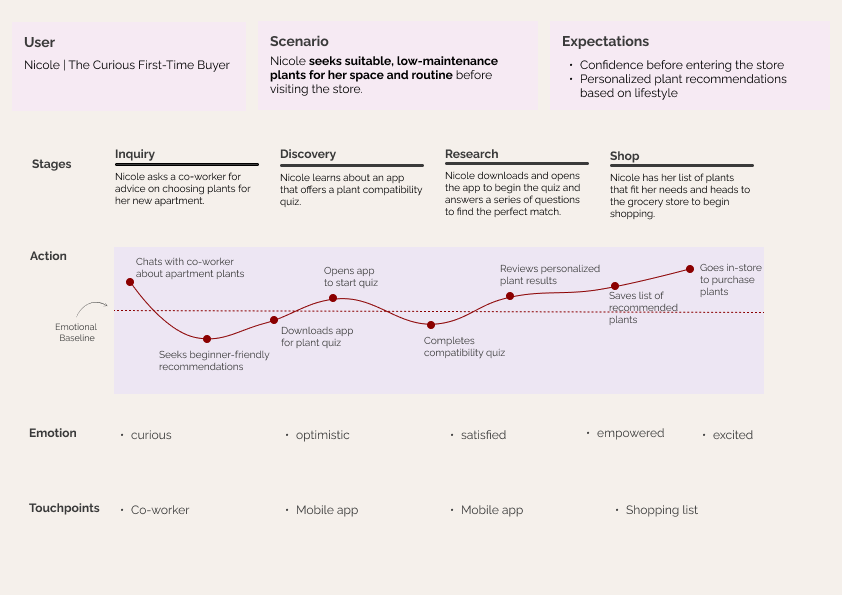
Turning Insights Into Action
Based on insights from field observations and interviews, we prioritized features aligned to the key needs of our personas. Features were mapped by impact and feasibility to guide an MVP strategy focused on building user trust, improving plant compatibility selection, and reducing post-purchase regret.
These findings shaped the design focus areas explored in the solution phase.
Design Solutions
Guided by user insights, I designed a mid-fidelity prototype focused on plant compatibility, care guidance, and user trust. Key features addressed beginner plant owner needs through simplified research, easy comparison, and accessible safety information.
Mid-Fidelity Prototype
The mid-fidelity prototype highlights key user flows supporting plant discovery and care management.
New users are guided through the Match Me quiz to identify plants suited to their specific lighting conditions and living environments, along with suggested purchase locations.
Logged-in users can efficiently manage plant maintenance by adding plants to a personalized watering schedule through a quick search and selection process.
Key Moments in the User Journey
This flow highlights user engagement points across onboarding, plant discovery, care management, and health diagnostics.
These solutions represent a first iteration rooted in user needs, with opportunities for continued refinement through usability testing and real-world feedback.
Future Opportunities for Enhancement
Building on the foundation of the mid-fidelity prototype, future iterations could unlock greater value for users by deepening safety transparency and personalized care.
Key opportunities include:
Visual PetSafe and Toxicity badges integrated directly into plant listings and detail views to streamline purchase confidence.
Smart care recommendations, such as real-time humidity and indoor temperature sensors, tailored to plant types and living environments.

